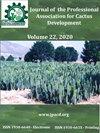仙人掌梨的加入改变了木棉青贮的发酵过程、化学成分和有氧稳定性
IF 0.4
4区 农林科学
Q4 HORTICULTURE
Journal of the Professional Association for Cactus Development
Pub Date : 2022-04-29
DOI:10.56890/jpacd.v24i.435
引用次数: 0
摘要
目的是评价树栖棉和仙人掌梨混合青贮饲料的发酵过程、营养品质和好氧稳定性。这是一个完全随机的设计,在树栖棉花青贮饲料中加入五个水平的仙人掌梨(0、15、30、45和60%),每个处理重复四次,总共20个实验单位。数据以5%的概率水平提交给I型误差的方差分析和回归分析。仙人掌梨的加入增加了气体损失(P<0.001)、废水损失(P>0.001)、缓冲能力损失(P=0.001)、需氧稳定性损失(P=0.010)和pH值上升趋势(P<0.01),青贮饲料的温度与环境的最大差异(P=0.005)和青贮饲料的最大pH(P<0.001)。仙人掌梨对青贮饲料最高温度的影响呈二次型(P<0.001)。干物质(P<0.001)、乙醚提取物(P<001)、有机物(P<0001)、粗蛋白(P=0002)和中性洗涤剂纤维对灰分和蛋白质的校正作用呈线性下降(P=0.030)。仙人掌梨的使用促进了矿物质(MM)水平的线性上升(P<0.01),对应于仙人掌梨每包含1%,增加0271%。青贮饲料中仙人掌梨比例的增加促进了矿物质的线性效应增加(P<0001)。仙人掌梨在树栖棉花青贮饲料中的含量高达60%,改变了发酵特性,增加了发酵损失,减少了营养。然而,它仍然呈现出优质硅烷的特点。本文章由计算机程序翻译,如有差异,请以英文原文为准。
The inclusion of cactus pear changes the fermentation process, chemical composition and aerobic stability of arboreal cotton silages
The objective was to evaluate the fermentation process, nutritional quality, and aerobic stability of mixed silages of arboreal cotton and cactus pear. This was a completely randomized design, with five levels of inclusion of cactus pear (0, 15, 30, 45, and 60%) in the arboreal cotton silage and four replications per treatment, totaling 20 experimental units. Data were submitted to analysis of variance and regression at a 5% probability level for type I error. The inclusion of cactus pear resulted in increased losses from gases (P<0.001), effluents (P<0.001), buffering capacity (P<0.001), aerobic stability (P = 0.010), and pH upward trend (P<0.001). There was a decreasing linear effect on dry matter recovery (P<0.001), pH (P<0.001), ammonia nitrogen (P <0.001), the maximum difference in the temperature of the silage in relation to the environment (P = 0.005) and maximum pH (P<0.001) of silages. The inclusion of cactus pear affected the maximum temperature (P<0.001) of silages in a quadratic way. There was a decreasing linear effect of dry matter (P<0.001), ether extract (P<0.001), Organic matter (P<0,001), crude protein (P = 0,002) and neutral detergent fiber corrected for ash and protein (P = 0.030). The use of cactus pear promoted an increasing linear effect for the levels of mineral matter (MM) (P<0.001), corresponding to an increase of 0,271%, for each 1% inclusion of cactus pear. The increase in the proportions of cactus pear in the silages promoted an increasing linear effect for mineral matter (P<0,001). The inclusion of cactus pear by up to 60% in arboreal cotton silages alters the fermentation profile with increased fermentation losses and nutritional reduction. However, it still presents characteristics of good quality silages.
求助全文
通过发布文献求助,成功后即可免费获取论文全文。
去求助
来源期刊

Journal of the Professional Association for Cactus Development
Agricultural and Biological Sciences-Plant Science
CiteScore
1.10
自引率
33.30%
发文量
10
期刊介绍:
The editors of the Journal of the Professional Association for Cactus Development, are very excited to be a part of the excellent editorial committee and to work together to create the synergism between scientists, growers, legislators, and business people so vital to the development of this industry to serve the people of arid lands.
 求助内容:
求助内容: 应助结果提醒方式:
应助结果提醒方式:


